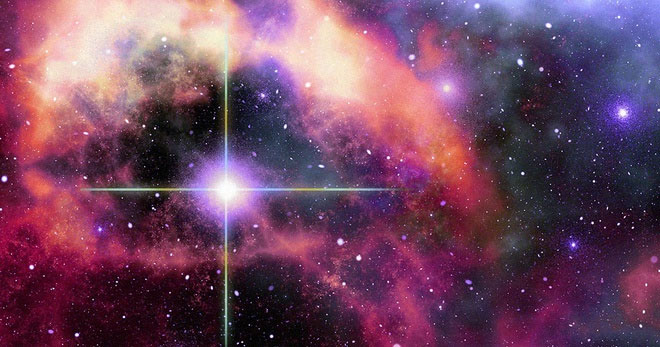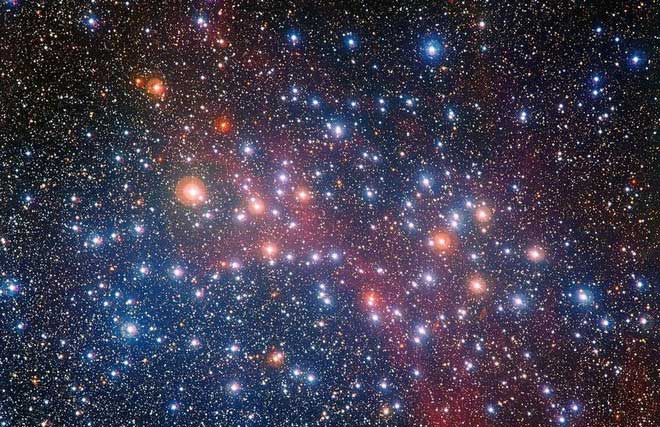Discovered the 'old' star nearly as close to space
The age of this star is only a few hundred million years smaller than the universe.
Scientists from the ARC Astrophysics Center for 3-D Astrophysics, Australian National University have found a super-old red giant star in the Milky Way.
About 35,000 light-years from Earth, the star named SMSS J160540.18–144323.1 has the lowest iron content of the stars ever analyzed.
That means this is one of the oldest stars in the universe, belonging to the second generation of stars after the universe formed 13.8 billion years ago.

The iron content of the world's oldest "star" is 1.5 million times lower than that of the Sun. (Photo: Futurism).
According to astronomer Thomas Nordlander, the star formed only a few hundred million years after the Big Bang, with iron content 1.5 million times lower than the Sun.
Measuring metal content is one of the methods for determining a star's age. There were no metals in the early universe. The stars of the first generation were formed from elements hydrogen and helium with very large size, hot and short life span. They are called population type III (population III) and have never been found by humans.
The star's energy is provided by nuclear fusion, in which the atomic nuclei of light elements are combined to create heavier elements.
Small stars usually fuse hydrogen to helium, but with larger stars like type III, nuclear reactions can produce elements like silicon and iron.
By the final stage of evolution, the star will explode (supernova phenomena), dispersing synthetic elements into the universe. When a new star is formed, the elements cling to them. That's why the metal content is used to determine a star's age.

This old star is several hundred million years younger than the universe. (Photo: Forbes).
In the past, the star with the lowest metal content in the Milky Way ever found was 2MASS J18082002–5104378 B with an iron content of -4.07 ± 0.07, which is about 11,750 times lower than the Sun's iron. .
As for SMSS J160540.18.18144323.1, the iron content of this star is -6.2 ± 0.2, which is 1.5 million times lower than the Sun.
Although Type III stars do not exist long enough for us to find them, the stars that form right after them help answer some of the questions.
According to Science Alert, scientists believe that the "gift" iron star for SMSS J160540.18–144323.1 has a relatively light mass compared to the early universe (about 10 times the mass of the Sun), large enough to create neutron stars, and end their lives after a small supernova.
A supernova could trigger a fast neutron (r) process, including a series of nuclear reactions in which the atomic nucleus collided with neutrons to synthesize elements heavier than iron.
There is no evidence of the presence of these elements in SMSS J160540.18–144323.1, suggesting that they were attracted to the dying neutron star. The "escape" iron elements have contributed to the formation of a new star, though it is also in the final evolutionary phase because of the very little remaining hydrogen.
- Close up of the star is said to have aliens living
- The mysterious age of the mysterious star
- Why does the star system have 3 super new Earth?
- Close up of a star's death
- Detecting unprecedented neutron stars, challenging the physical limit
- For the first time, a star has been discovered in a star
- Close up of dead star
- The 'eat' star companion in binary
- The scientists were skeptical of discovering Star Death
- Detecting a new satellite of Neptune
- Witness the giant star's death
- Pole Star
 Van Allen's belt and evidence that the Apollo 11 mission to the Moon was myth
Van Allen's belt and evidence that the Apollo 11 mission to the Moon was myth The levels of civilization in the universe (Kardashev scale)
The levels of civilization in the universe (Kardashev scale) Today Mars, the sun and the Earth are aligned
Today Mars, the sun and the Earth are aligned The Amazon owner announced a secret plan to build a space base for thousands of people
The Amazon owner announced a secret plan to build a space base for thousands of people The 'red monster' that Sima Qian mentioned caused illusions on Earth?
The 'red monster' that Sima Qian mentioned caused illusions on Earth?  This fruit has a sweet and sour taste that is as good as 'natural insulin', helping to lower blood sugar and nourish bones effectively.
This fruit has a sweet and sour taste that is as good as 'natural insulin', helping to lower blood sugar and nourish bones effectively.  A shooting star, about to explode in the sky of Earth?
A shooting star, about to explode in the sky of Earth?  Image of a new star spewing gas loudly across the Milky Way galaxy
Image of a new star spewing gas loudly across the Milky Way galaxy  The 'deadly' truth about strange radio signals transmitted to Earth
The 'deadly' truth about strange radio signals transmitted to Earth  Scientists Stunned to Discover Star With Supersonic Tsunamis Three Times Higher Than the Sun
Scientists Stunned to Discover Star With Supersonic Tsunamis Three Times Higher Than the Sun 